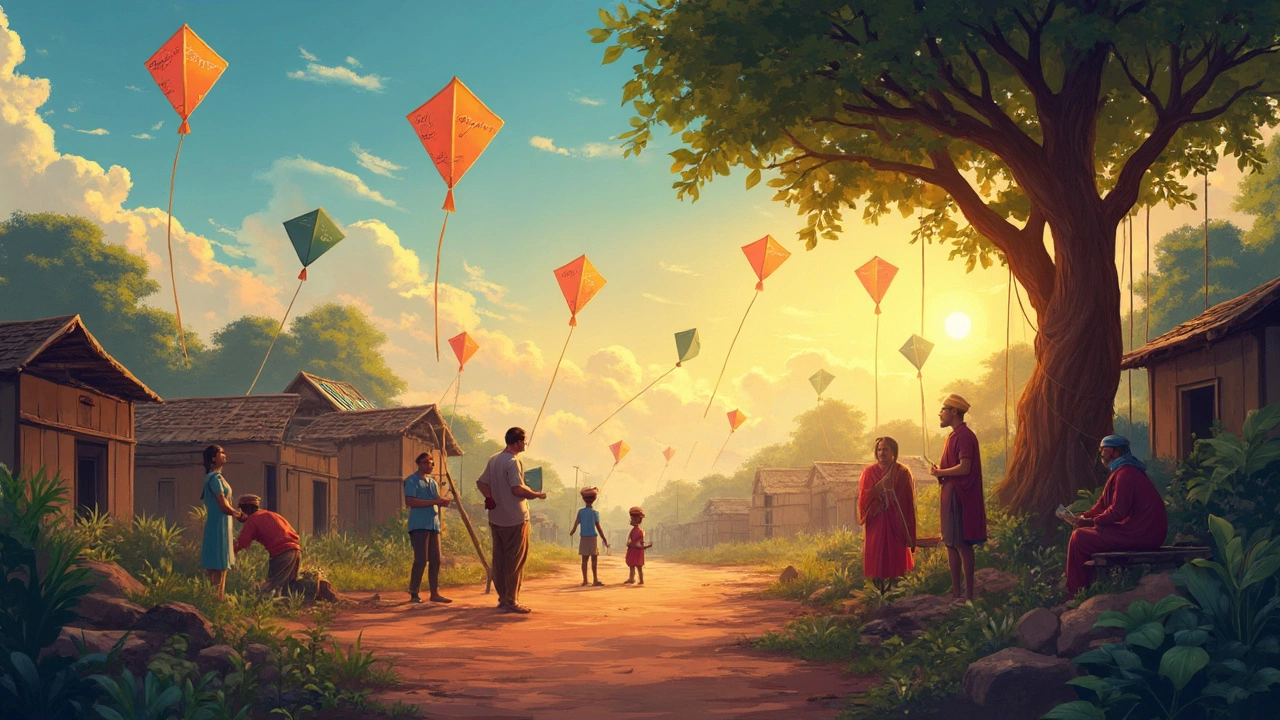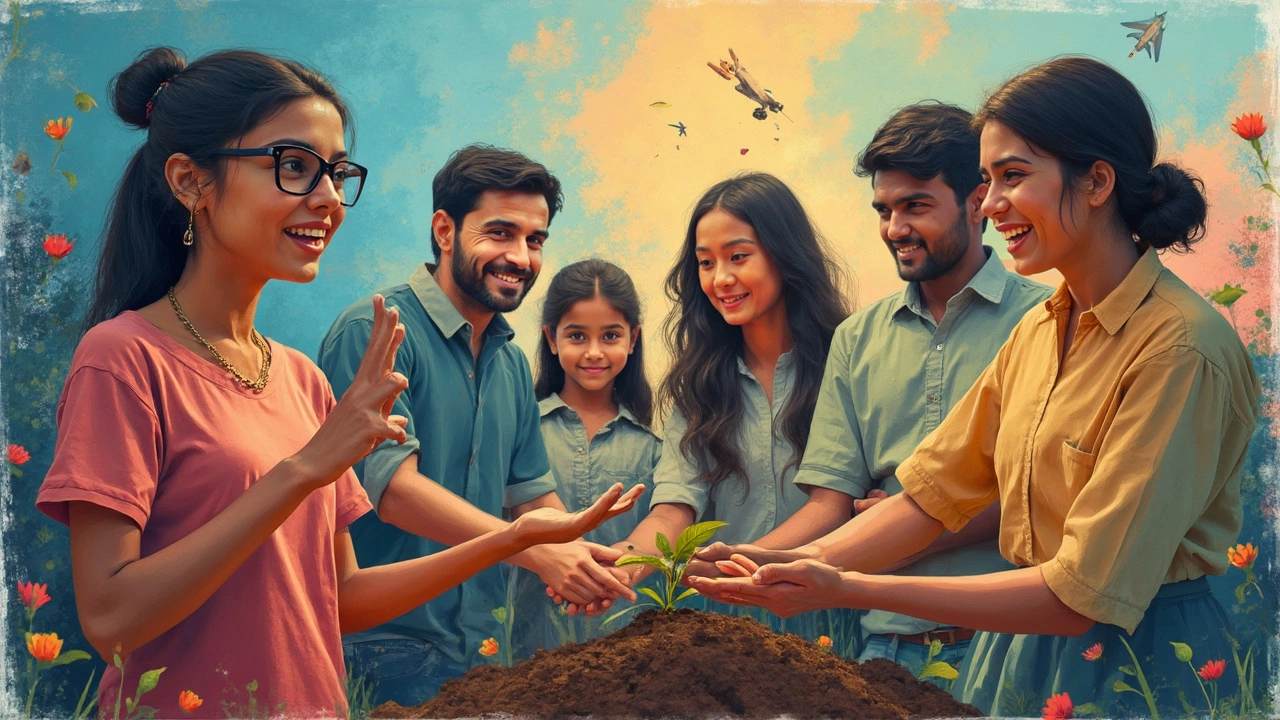India's Dream: Vision, Aspirations, and the Path Forward

Walk through any city in India—tiny tea stalls wedged between glitzy malls, giant billboards pushing technology, or a group of students absorbed in coding tutorials under a street light, laptops balanced on knees. The air buzzes with determination. What actually keeps over a billion people moving forward, sweating, dreaming, and often grinding it out day after day? India’s dream can't be crammed into a single punchline or neat slogan. It’s tangled and enormous, but somehow clear when you spot a chai-wallah talking about his daughter's education or a young engineer planning a startup launch from her tiny room. So, what's India's dream?
The Roots of Aspiration: What Shapes India's Dream?
India’s vastness means its dreams are built from millions of different hopes and stories. There’s no single thread, but there is a clear drive—a shared hunger to live better, learn more, and be counted in the world. The idea of 'dreaming big' isn’t recent. Dr. A.P.J. Abdul Kalam, a rocket scientist turned people's president, famously said, "Dreams are not what you see in sleep, dreams are things which do not let you sleep." His vision, called India Vision 2020, laid the groundwork for modern aspirations: clean drinking water, quality education, advanced infrastructure, and self-reliance in technology.
But people’s hearts beat for their own versions. Ask a parent in Pune, a student in Kolkata, or a farmer in Haryana, and you’ll hear about decent jobs, college, health, respect, or financial freedom. It’s sometimes about making parents proud, but often just about cracking a competitive exam or buying a scooter. Yet, there is a powerful collective undertone: every step forward feeds a national mood of possibility.
Historically, Indian dreams were shadowed by colonial rule, partition, and poverty. Independence in 1947 rewired everything. Suddenly, ambition had a seat at the table. Today’s dreams mix tech, tradition, Bollywood sparkle, demands for equality, and a solid yearning for global recognition—India wants to be seen, not just as the world’s largest democracy, but as a big player with influence. This isn’t chest-thumping nationalism, but a push to move the whole country ahead so fewer are left behind.
There’s also a generational twist. A 2021 Pew Research study showed over 60% of Indians under 35 believe their lives are better than their parents’, and 70% are convinced their children will do even better. That kind of optimism shapes risk-taking—from tiny businesses to bold discoveries in AI and renewable energy.
Economic Dreams: Growth, Jobs, and Middle-Class Hope
If you want to trace what most Indians demand from the future, follow the money and the opportunities. Economic growth fills every conversation. The country's GDP shot up from $189 billion in 1980 to nearly $3.7 trillion by 2024. Middle-class families—once barely a blip—now make up more than 30% of the population. That’s hundreds of millions of people aspiring for cars, homes, travel visas, and better healthcare.
Jobs dominate the dream. India produces over 1.2 million engineers every year, outpacing most of the world, but also faces a severe job crunch as automation, AI, and global competition make it harder for freshers to get employed. That’s where the hustle kicks in. Young people are turning to startups, freelancing, and gig work. The digital revolution, powered by cheap mobile data (think Jio’s 2016 market shake-up), has made it easier to access global markets, pick up skills, and leap over old-school barriers.
Lately, there’s a push for “Make in India.” Manufacturing isn’t just about bigger GDP numbers; it’s about dignity. Villages that used to send workers to cities are building factories, small businesses, and farms that leverage tech and logistics to reach customers nationwide. In fact, exports crossed the $418 billion mark in 2023, showing how eager the world is for Indian goods—from textiles to cutting-edge software.
| Year | GDP (USD Trillion) | Middle-Class Population (Millions) | Exports (USD Billion) |
|---|---|---|---|
| 1991 | 0.27 | 25 | 18 |
| 2001 | 0.5 | 50 | 44 |
| 2011 | 1.7 | 160 | 309 |
| 2024 | 3.7 | 430 | 418 |
Yet, the story isn’t all bright screens and booming salaries. Rural India—where two-thirds of the country lives—wants more stable farming income, better weather forecasts, and ways to sell produce at fair prices. The government’s schemes like PM-KISAN (giving direct payments to farmers) and rural employment programs help, but the process often gets tangled in red tape and tough weather conditions.
Housing and health are must-haves for the dream, not perks. The target is clear: every family with a solid roof, every kid with vaccines, every elder with pension security. The pace is slow and grinding, but the sheer scale of ambition—600 million new toilets built under Swachh Bharat (Clean India) or over 200 million new bank accounts opened in a push for financial inclusion—reminds you how gigantic the collective effort is.

Education, Innovation, and the Young Indian Dreamer
The burning engine behind India’s future isn’t oil, coal, or flashy buildings—it’s education. Walk into any home, rich or poor, and you’ll see textbooks, tuitions, or fierce debates about which field to choose: coding or medicine, CA or civil service, or maybe a gig in animation or gaming that didn’t exist a decade ago. The stakes are sky-high. For many, education is the only reliable escape out of poverty or obscurity.
Consider this: India now has more than 1,000 universities and nearly 43,000 colleges. The annual number of students graduating is close to 9 million, one of the highest in the world. But the reality inside those classrooms isn’t uniform. Urban colleges might have 5G and AR tech labs, but rural schools still scramble for fans and light bulbs. Closing the education gap is a common dream, repeated across languages and regions.
India’s innovation push is wild. The country is a beast in IT services: about 5 million people work in tech, making India the world’s largest pool of software engineers outside the United States. Indian startups are storming the scene: unicorns (startups valued at over $1 billion) jumped from just a handful in 2017 to over 110 by 2024. Yet, success is earned—funding can be tight, competition is ruthless, and every founder knows how often reality throws curveballs. Still, the mood is infectious—people want to invent, disrupt, and build. The National Education Policy (NEP) 2020 is designed to make learning less rote, more flexible, and creativity-driven. It’s still early days, but the idea is catching on in urban hubs.
- Tip: Real skill-building is now about hands-on projects—coding bootcamps, art installations, internships with NGOs, or working in family businesses teach resilience far beyond textbooks.
- Fact: In 2024, India sent a record 700,000 students to study abroad, not because they don’t love their homeland, but because there’s hunger for the world’s best knowledge—and then bringing those ideas home.
- Tip: English fluency helps in job hunts, but local languages are reclaiming value as startups, content, and e-commerce tap non-English customers.
- Fact: By 2040, the United Nations predicts India will have the world’s largest working-age population, reshaping not just India, but global tech, healthcare, and finance sectors.
Social Progress and Identity: Dreams Around Equality
Dreams aren’t just about chasing money or degrees. There’s a fierce desire to fix old wounds—caste, gender, religion, and class. India is packed with historic divisions, but social change is real, even if it stumbles. You see it in women demanding equal pay in Bengaluru’s tech companies, or in Dalit students raising their voices in universities, or young couples choosing who they want to marry, no matter their parents’ opinion.
Take gender: Indian women have pushed forward in politics, sports, and business. In 2024, the Women’s Reservation Bill finally moved ahead, aiming to reserve 33% of seats in Parliament and state legislatures for women—a fight over 25 years old. Still, only about 22% of women are part of the formal workforce, so the road is long. On the flip side, millions of women run small businesses from home and lead self-help groups, proving how much entrepreneurial spirit is bubbling under the surface.
Caste bias hasn’t vanished, but every generation chips away. Reservation policies for marginalized groups remain a hot-button topic—essential for many, a source of debate for others—but they do pull millions into colleges and public jobs each year. Urban kids, more than ever, are learning to check privilege and see through old stereotypes. There is something contagious about watching viral Insta reels where a rapper from a Dalit community shreds prejudice or a Bollywood star takes a public stand for LGBTQ+ rights.
Religion and identity dominate headlines, sometimes creating friction. But scratch beneath the noise, and clashing dreams often end up side-by-side: Christmas lights shimmer next to Diwali lamps and Eid sweets make their way into Holi parties. It’s messy but magical. India’s dream isn’t about everyone being the same, but about finding space for every voice. The balancing act is tough—social media and news can drive conflict, but equally, it can amplify kindness and unity in ways that ripple out for millions to see.
Movements like Swachh Bharat (cleanliness), Beti Bachao Beti Padhao (girls’ education), and Digital India don’t just work top-down; they rely on people taking ownership. Volunteers clean up rivers, women police officers mentor girls, and ordinary citizens help register millions for digital IDs. These efforts aren’t perfect, but they show that grassroots change is what really powers India’s dream.

Looking Ahead: India’s Dream in 2047 and Beyond
Every country imagines itself leading the future, but India’s vision for 2047 (its 100th year of independence) is loud and clear in public policy, political speeches, and pop culture. “Viksit Bharat” (Developed India) isn’t just about rankings; it’s about wiping out poverty, achieving universal literacy, high-speed transit from Kashmir to Kanyakumari, and truly world-class healthcare. Everyone wants their children to grow up in a country that isn’t battling for basic dignity but thriving side by side with the world’s biggest economies.
Ambitions are sky-high. The nation wants to triple its energy output with renewables, aiming for 500 GW of green power by 2030—think gigawatt solar farms in Rajasthan and wind turbines in Tamil Nadu. Space dreams? After the moon landing, the Indian Space Research Organisation has set its target on a manned mission to space by 2030 and even a Venus orbiter. The private sector and government both want to build a digital Rupee, with crypto and fintech innovation booming out of places like Bengaluru and Hyderabad.
But the dream isn’t just digital or economic. There are plans to reforest millions of hectares, restore rivers, and protect wildlife. Conservation is now, finally, cool—with Indian icons speaking about the benefit of clean air or even organic farming in rural villages. There’s a growing enthusiasm for sustainable practices, from using public transport to organic courtyard farming and crafts revival, as the country realizes the future must be healthy and resilient—not just rich.
Here’s the twist: the world is watching. With its young population, India will shape not just its destiny, but much of the globe’s—via movies, music, cuisine, innovation, and even international policies. Indians abroad are making noise too: CEOs of Google, Microsoft, and dozens of other global giants trace their roots back to India. Young coders in Kerala Zoom into Silicon Valley teams every morning. Scientists collaborate on climate and medical research. Influence works both ways.
So what exactly India's dream? If you try to pin it down to one thing, you’ll miss the whole magic. It’s messy and ambitious, new and old, fiercely individual but held together by a stubborn optimism. It’s the kid building a circuit for a rural science fair, a grandma learning WhatsApp, the delivery rider opening a mutual fund, and the celebrity giving away money to medical causes. Most of all, it’s the world’s most massive collective leap—a billion stories, crammed into one wild, surging, imperfect, unbeatable dream.